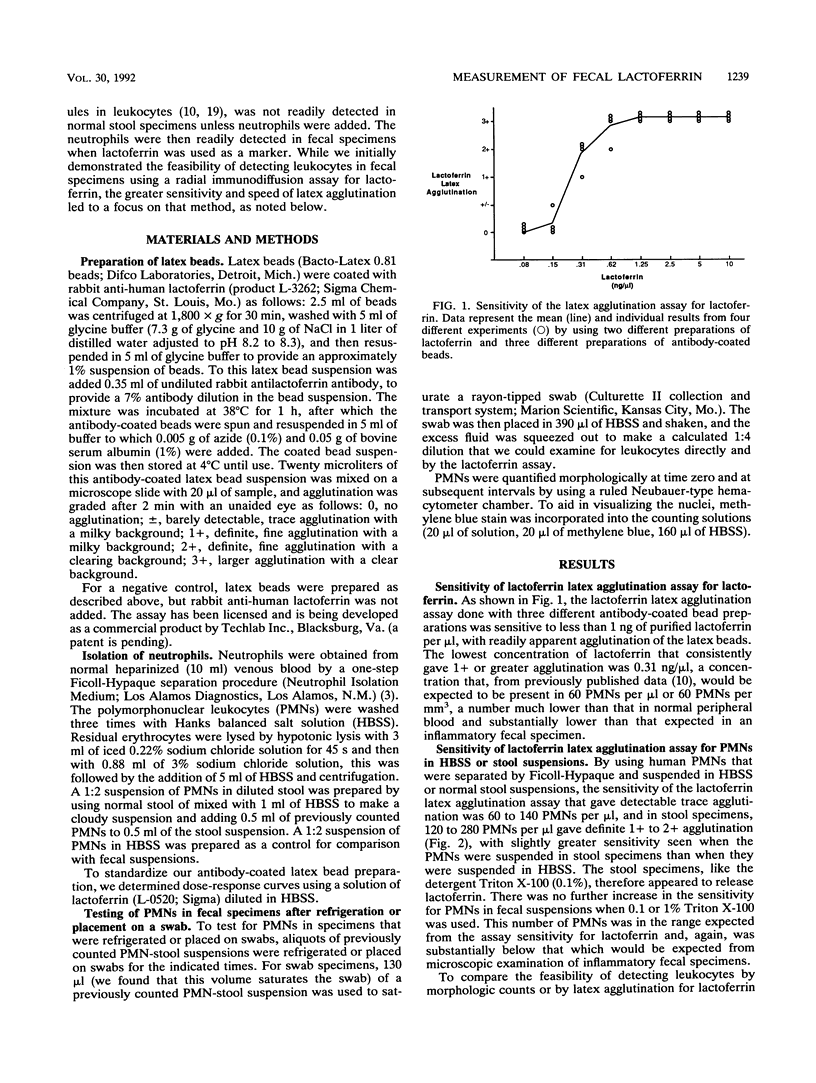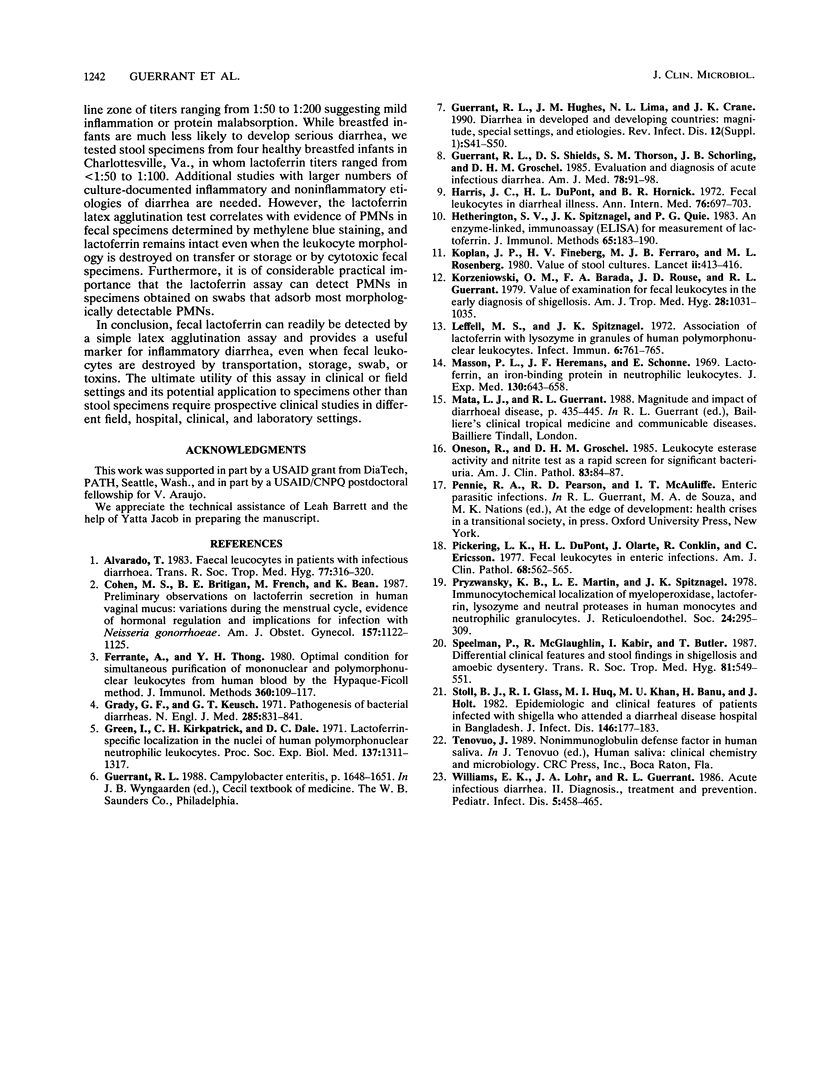Abstract
While diarrheal illnesses are extremely common in communities and hospitals throughout the world, an etiologic diagnosis may be expensive and cost-ineffective. Although the presence of fecal leukocytes are helpful in the diagnosis and specific therapy of inflammatory diarrheas, this requires prompt microscopic examination of fecal specimens (preferably obtained in a cup rather than a swab or diaper) by a trained observer. We developed a simple, sensitive test for the detection of leukocytes in fecal specimens using antilactoferrin antibody. Whereas radial immunodiffusion detected 0.02 micrograms of lactoferrin (LF) per microliter or greater than or equal to 2,000 leukocytes per microliter, latex agglutination (LA) readily detected greater than or equal to 0.001 micrograms of LF per microliter or greater than or equal to 200 leukocytes per microliter added to stool specimens. Despite the destruction or loss of morphologic leukocytes on storage for 1 to 7 days at 4 degrees C or placement of specimens on swabs, measurable LF remained stable. Initial studies of stool specimens from six patients with Salmonella or Clostridium difficile enteritis were positive and those from three controls were negative for LF by LA. Of 17 children in Brazil with inflammatory diarrhea (greater than or equal to 1 leukocyte per high-power field), 16 (94%) had LF titers of greater than 1:50 by LA, whereas only 3 of 12 fecal specimens with less than 1 leukocyte per high-power field on methylene blue examination and none of 7 normal control specimens had an LF titer of greater than 1:50 by LA. Of 16 fecal specimens from patients with C. difficile diarrhea (cytotoxin titers, >/= 1:1,000), 95% (n = 15) had detectable LF by LA (in titers of 1:100 to 1: 800). Finally, of 48 fecal specimens from healthy adult U.S. volunteers before and after experimental shigellosis and of 29 fecal specimens from children with documented shigellosis and hospitalized controls in northeastern Brazil, fecal LF titers ranged from 1:200 to >/= 1:5,000 in 96% (25 of 26) samples from patients with shigellosis (and reported positive for fecal leukocytes), while 51 controls consistently had fecal LF titers of </= 1:200. We conclude that fecal LF is a useful marker for fecal leukocytes, even when they are morphologically lost swab specimens or when they are destroyed on transport or storage or by cytotoxic fecal specimens.
Full text
PDF




Selected References
These references are in PubMed. This may not be the complete list of references from this article.
- Alvarado T. Faecal leucocytes in patients with infectious diarrhoea. Trans R Soc Trop Med Hyg. 1983;77(3):316–320. doi: 10.1016/0035-9203(83)90151-7. [DOI] [PubMed] [Google Scholar]
- Cohen M. S., Britigan B. E., French M., Bean K. Preliminary observations on lactoferrin secretion in human vaginal mucus: variation during the menstrual cycle, evidence of hormonal regulation, and implications for infection with Neisseria gonorrhoeae. Am J Obstet Gynecol. 1987 Nov;157(5):1122–1125. doi: 10.1016/s0002-9378(87)80274-0. [DOI] [PubMed] [Google Scholar]
- Ferrante A., Thong Y. H. Optimal conditions for simultaneous purification of mononuclear and polymorphonuclear leucocytes from human blood by the Hypaque-Ficoll method. J Immunol Methods. 1980;36(2):109–117. doi: 10.1016/0022-1759(80)90036-8. [DOI] [PubMed] [Google Scholar]
- Grady G. F., Keusch G. T. Pathogenesis of bacterial diarrheas. I. N Engl J Med. 1971 Oct 7;285(15):831–841. doi: 10.1056/NEJM197110072851505. [DOI] [PubMed] [Google Scholar]
- Green I., Kirkpatrick C. H., Dale D. C. Lactoferrin--specific localization in the nuclei of human polymorphonuclear neutrophilic leukocytes. Proc Soc Exp Biol Med. 1971 Sep;137(4):1311–1317. doi: 10.3181/00379727-137-35779. [DOI] [PubMed] [Google Scholar]
- Guerrant R. L., Hughes J. M., Lima N. L., Crane J. Diarrhea in developed and developing countries: magnitude, special settings, and etiologies. Rev Infect Dis. 1990 Jan-Feb;12 (Suppl 1):S41–S50. doi: 10.1093/clinids/12.Supplement_1.S41. [DOI] [PMC free article] [PubMed] [Google Scholar]
- Guerrant R. L., Shields D. S., Thorson S. M., Schorling J. B., Gröschel D. H. Evaluation and diagnosis of acute infectious diarrhea. Am J Med. 1985 Jun 28;78(6B):91–98. doi: 10.1016/0002-9343(85)90370-5. [DOI] [PubMed] [Google Scholar]
- Harris J. C., Dupont H. L., Hornick R. B. Fecal leukocytes in diarrheal illness. Ann Intern Med. 1972 May;76(5):697–703. doi: 10.7326/0003-4819-76-5-697. [DOI] [PubMed] [Google Scholar]
- Hetherington S. V., Spitznagel J. K., Quie P. G. An enzyme-linked immunoassay (ELISA) for measurement of lactoferrin. J Immunol Methods. 1983 Dec 16;65(1-2):183–190. doi: 10.1016/0022-1759(83)90314-9. [DOI] [PubMed] [Google Scholar]
- Koplan J. P., Fineberg H. V., Ferraro M. J., Rosenberg M. L. Value of stool cultures. Lancet. 1980 Aug 23;2(8191):413–416. doi: 10.1016/s0140-6736(80)90453-5. [DOI] [PubMed] [Google Scholar]
- Korzeniowski O. M., Barada F. A., Rouse J. D., Guerrant R. L. Value of examination for fecal leukocytes in the early diagnosis of shigellosis. Am J Trop Med Hyg. 1979 Nov;28(6):1031–1035. doi: 10.4269/ajtmh.1979.28.1031. [DOI] [PubMed] [Google Scholar]
- Leffell M. S., Spitznagel J. K. Association of lactoferrin with lysozyme in granules of human polymorphonuclear leukocytes. Infect Immun. 1972 Nov;6(5):761–765. doi: 10.1128/iai.6.5.761-765.1972. [DOI] [PMC free article] [PubMed] [Google Scholar]
- Masson P. L., Heremans J. F., Schonne E. Lactoferrin, an iron-binding protein in neutrophilic leukocytes. J Exp Med. 1969 Sep 1;130(3):643–658. doi: 10.1084/jem.130.3.643. [DOI] [PMC free article] [PubMed] [Google Scholar]
- Oneson R., Gröschel D. H. Leukocyte esterase activity and nitrite test as a rapid screen for significant bacteriuria. Am J Clin Pathol. 1985 Jan;83(1):84–87. doi: 10.1093/ajcp/83.1.84. [DOI] [PubMed] [Google Scholar]
- Pickering L. K., DuPont H. L., Olarte J., Conklin R., Ericsson C. Fecal leukocytes in enteric infections. Am J Clin Pathol. 1977 Nov;68(5):562–565. doi: 10.1093/ajcp/68.5.562. [DOI] [PubMed] [Google Scholar]
- Pryzwansky K. B., Martin L. E., Spitznagel J. K. Immunocytochemical localization of myeloperoxidase, lactoferrin, lysozyme and neutral proteases in human monocytes and neutrophilic granulocytes. J Reticuloendothel Soc. 1978 Sep;24(3):295–310. [PubMed] [Google Scholar]
- Speelman P., McGlaughlin R., Kabir I., Butler T. Differential clinical features and stool findings in shigellosis and amoebic dysentery. Trans R Soc Trop Med Hyg. 1987;81(4):549–551. doi: 10.1016/0035-9203(87)90402-0. [DOI] [PubMed] [Google Scholar]
- Stoll B. J., Glass R. I., Huq M. I., Khan M. U., Banu H., Holt J. Epidemiologic and clinical features of patients infected with Shigella who attended a diarrheal disease hospital in Bangladesh. J Infect Dis. 1982 Aug;146(2):177–183. doi: 10.1093/infdis/146.2.177. [DOI] [PubMed] [Google Scholar]
- Williams E. K., Lohr J. A., Guerrant R. L. Acute infectious diarrhea. II. Diagnosis, treatment and prevention. Pediatr Infect Dis. 1986 Jul-Aug;5(4):458–465. doi: 10.1097/00006454-198607000-00017. [DOI] [PubMed] [Google Scholar]


